Next Monday (Sept. 26), U.S. voters will witness the first presidential debate of the 2016 election cycle.
The showdown between Democratic presidential nominee Hillary Clinton and GOP presidential nominee Donald Trump is expected to shatter viewership records -- a whopping 75% of registered voters plan to watch the first Trump-Clinton debate, according to a Morning Consult poll released Monday (Sept. 18). If accurate, that means 95 million Americans will tune in.
Compared to the first presidential debate of the 2012 election cycle -- the faceoff between Mitt Romney and President Obama brought in 70 million viewers -- 25 million more viewers are expected to watch on Monday night.
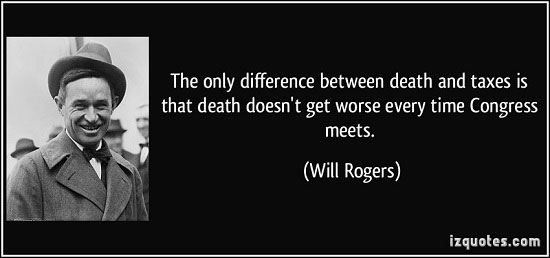
Folks will tune into this first of three presidential debates to find out where these two politicians stand on the policies most important to them. And presently, that most important issue is the state of the U.S. economy...
You see, according to a CBS/New York Times poll taken between Sept. 9 and Sept. 13, "economy and jobs" topped all other voter concerns (national security, healthcare, immigration, and "something else") at 32%.
Don't Miss: This is the Worst Economy Since WWII. Here's Why...
And when it comes to fiscal policy, some of the biggest differences between the candidates are what they want to do to your taxes...
First Presidential Debate: 3 Key Differences on U.S. Tax Policy
Key Difference No. 1: Individual Tax Rates
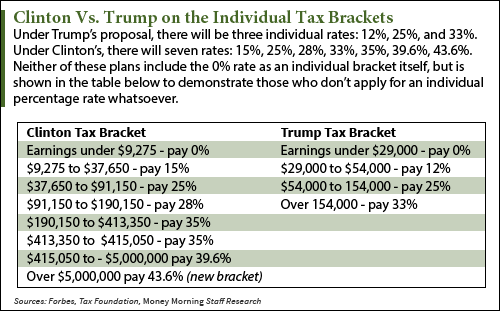
Hillary Clinton's Stance: Clinton talked tax policy at a rally in Cleveland on Aug. 17. She envisions a .4% tax surcharge for income over $5 million, meaning that the very highest earners would effectively have a nearly 44% top marginal rate. This top marginal rate, where highest earners exist (in the table above), would under Clinton become the 43.6% they're required to pay right now, plus another 0.4%. Essentially, these taxpayers would be getting charged for just being in the top income bracket.
Clinton also wants to implement a rule that those with income over $1 million would pay a rate of at least 30% -- but as high as 39.6%. This is aimed at preventing top earners from paying low overall rates thanks to the lower capital gains tax (which is a tax levied on profit from the sale of property or of an investment).
Furthermore, the former secretary of state would limit the value of tax deductions. In other words, she would trim down the possibilities for high-income earners to make exorbitantly expensive deductions just because they could afford a pricey item in the first place.
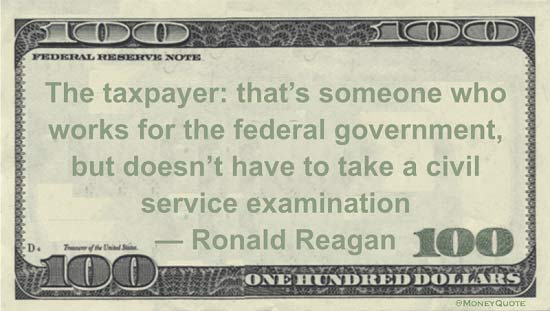
And last but not least, Clinton would require longer holding periods to get the low long-term capital gains tax rate.
These overall changes proposed by Clinton, in short, would make the tax code a lot less favorable to the affluent.
Donald Trump's Stance: Trump's plan would boost the standard deduction from $6,300 to $15,000 for single filers, and from $12,600 to $30,000 for married filers. In other words, the amount you can deduct would be much higher under a President Trump.
The billionaire businessman would also cut the top marginal income tax rate from 39.6% to 33%. A July 5 analysis by The Tax Foundation of the House Republicans' tax plan, on which Trump's is based, found it would increase after-tax income for the richest 1% by 5.3%.
Key Difference No. 2: Corporate Tax Rates
[mmpazkzone name="in-story" network="9794" site="307044" id="137008" type="4"]
Hillary Clinton's Stance: Clinton released a plan to impose a corporate "exit tax" on Dec. 9, 2015 (the exact percentage of the "exit tax" was not revealed) that would penalize mergers between U.S. companies and foreign corporations structured to reduce their taxes -- a move known as a "tax inversion."
The plan came after New York-based drug company Pfizer Inc. (NYSE: PFE) announced in November 2015 its intention to merge with Ireland-based Allergan Plc. (NYSE: AGN). The move would have enabled Pfizer to reduce its tax rate from around 25% in 2015 to about 18% this year. However, on April 6, 2016, the U.S. Treasury Department effectively killed the merger by issuing sudden changes to corporate tax inversion laws.
Get Our Best Wealth-Building Ideas: Money Morning's top 5 investment reports to grow your money like never before are right here - and they're absolutely free. Read more...
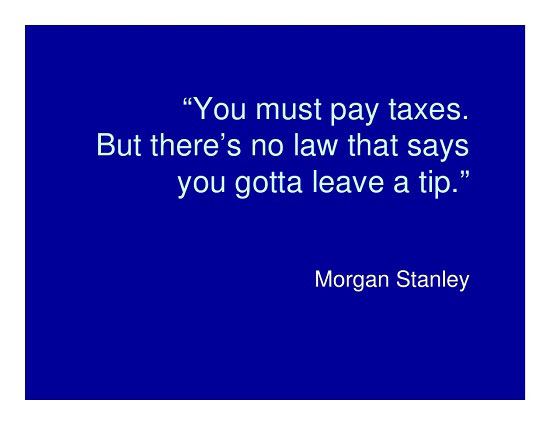
Donald Trump's Stance: Trump said he would sharply cut the top tax rate on corporate profits from 35% to 15% to bring big businesses back to America. You see, according to Cato Institute research published in September 2012, the United States has the highest corporate tax rate among major industrial nations. Its effective tax rate of 35.6% on new corporate investment is nearly twice the average rate for the 90 countries studied.
The real estate mogul claimed on his website on Monday that even small businesses could elect to be taxed using the business tax rate of 15%, or they could choose to be taxed according to ordinary individual income rates. (See Trump's revised tax bracket proposal in the table above.)
With the new, lower rate, businesses that earn money overseas and currently keep it outside the United States would have less incentive to do so -- meaning they might repatriate money back to the United States.
Key Difference No. 3: The Federal Budget Deficit
The United States is on track to have a budget deficit of $590 billion in the current fiscal year and a total of $9.3 trillion over the coming decade, the Congressional Budget Office estimated on Aug. 23. That would gradually push the total debt relative to the economy to 86% from about 75%.
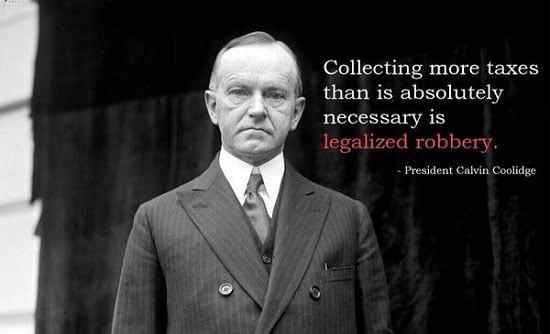
Hillary Clinton's Stance: Clinton's comprehensive tax proposals are estimated to increase federal revenue by $1.1 trillion over the decade, reported The New York Times on Aug. 13, 2016. She has said she would use that increased revenue to cover the cost of other policy proposals, with the intention of making her overall agenda have a neutral effect on the budget deficit.
Donald Trump's Stance: Trump's tax plan would reduce federal revenue by an estimated $9.5 trillion over the next decade, reported The New York Times. If not offset by either spending cuts or major economic growth, that would make cumulative budget deficits over the decade roughly twice as big as they are currently estimated to be, according to the NYT.
Up Next
While radical tax reform is needed - and swiftly - here in the United States, there is one place where we actually need more taxes...
Here's Money Morning Global Credit Strategist Michael E. Lewitt, whose 29-year career as a money manager saw him handling billions of dollars for high-net-worth clients, on why Wall Street needs to start paying for Main Street.
Here's what's being said about the first presidential debate on Twitter:


